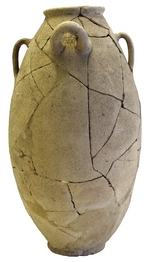Roman Amphorae: a digital resource
University of Southampton, 2005. (updated 2014) https://doi.org/10.5284/1028192. How to cite using this DOI
Data copyright © University of Southampton unless otherwise stated
This work is licensed under the ADS Terms of Use and Access.
Primary contact
Dr
David
Williams
Dept of Archaeology
University of Southampton
Avenue Campus
Highfield
Southampton
SO17 1BJ
England
Tel: 080 593032
Resource identifiers
- ADS Collection: 463
- DOI:https://doi.org/10.5284/1028192
- How to cite using this DOI
Camulodunum 176

Copyright of Castle Museum, Colchester
Stephen Yates
Distinctive FeaturesStrictly speaking this is not an amphora shaped-vessel, but it does seem to have travelled long distances and is large enough to have carried a considerable quantity of goods. It is a large four-handled jar with a slightly swelling ovoid body and flat base. The handles are alternately horizontal [shorter and rounded section] and vertical [longer and narrow and flattened] on a broad neck. There is a small triangular-shaped rim.See characteristics | ||
Date RangeThe examples from Camulodunum were dated before c. AD 65 (Hawkes & Hull, 1947), while the Augst vessels date to between the first half of the first till the middle of the second centuries AD (Martin-Kilcher, 1994).Search: [1st century AD] [2nd century AD] | ||
OriginNot known for certain but almost certainly Italian.Search: [Italy] [North West Europe] | ||
DistributionPresent at Camulodunum (Hawkes & Hull, 1947), Haltern and Augst (Martin-Kilcher, 1994).Search: [Germany] [Great Britain] [North West Europe] [Switzerland] | ||
ContentsUnknown although wine or perhaps preserved grapes are possibilities (Martin-Kilcher, 1994).Search: [Fruit] [Wine] | ||
CommentsPrincipal contributor: David Williams |



 3D models
3D models


